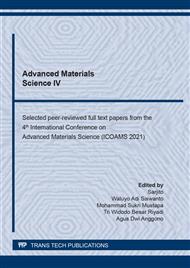[1]
Michler, J., & Blank, E. (2001). Analysis of coating fracture and substrate plasticity induced by spherical indentors: diamond and diamond-like carbon layers on steel substrates. Thin solid films, 381(1), 119-134.
DOI: 10.1016/s0040-6090(00)01340-7
Google Scholar
[2]
Kot, M., Rakowski, W., Lackner, J. M., & Major, Ł. (2013). Analysis of spherical indentations of coating-substrate systems: experiments and finite element modeling. Materials & Design, 43, 99-111.
DOI: 10.1016/j.matdes.2012.06.040
Google Scholar
[3]
Martinez, E., Romero, J., Lousa, A., & Esteve, J. (2003). Nanoindentation stress–strain curves as a method for thin-film complete mechanical characterization: application to nanometric CrN/Cr multilayer coatings. Applied Physics A, 77(3), 419-426.
DOI: 10.1007/s00339-002-1669-0
Google Scholar
[4]
Nagentrau, M., Tobi, A. L. M., Jamian, S., & Otsuka, Y. (2020). HAp Coated Hip Prosthesis Contact Pressure Prediction Using FEM Analysis. In Materials Science Forum (Vol. 991, pp.53-61). Trans Tech Publications Ltd.
DOI: 10.4028/www.scientific.net/msf.991.53
Google Scholar
[5]
Siswanto, W. A., Nagentrau, M., Tobi, M., & Latif, A. (2015). Prediction of residual stress using explicit finite element method. Journal of Mechanical Engineering and Sciences, 9, 1556-70.
Google Scholar
[6]
Nagentrau, M., Tobi, A. M., Jamian, S., Otsuka, Y., & Hussin, R. (2021). Delamination-fretting wear failure evaluation at HAp-Ti-6Al–4V interface of uncemented artificial hip implant. Journal of the mechanical behavior of biomedical materials, 122, 104657.
DOI: 10.1016/j.jmbbm.2021.104657
Google Scholar
[7]
Nagentrau, M., Siswanto, W. A., Tobi, M., & Latif, A. (2016). Predicting the sliding amplitude of plastic deformation in the reciprocating sliding contact. ARPN Journal of Engineering and Applied Sciences, 11(4), 2266-2271.
Google Scholar
[8]
Siswanto, W. A., Nagentrau, M., Tobi, A. M., & Tamin, M. N. (2016). Prediction of plastic deformation under contact condition by quasi-static and dynamic simulations using explicit finite element analysis. Journal of Mechanical Science and Technology, 30(11), 5093-5101.
DOI: 10.1007/s12206-016-1027-3
Google Scholar
[9]
Holmberg, K., Ronkainen, H., Laukkanen, A., & Wallin, K. (2007). Friction and wear of coated surfaces—scales, modelling and simulation of tribomechanisms. Surface and Coatings Technology, 202(4-7), 1034-1049.
DOI: 10.1016/j.surfcoat.2007.07.105
Google Scholar
[10]
Zhao, X., Xie, Z., & Munroe, P. (2011). Nanoindentation of hard multilayer coatings: Finite element modelling. Materials Science and Engineering: A, 528(3), 1111-1116.
DOI: 10.1016/j.msea.2010.09.073
Google Scholar
[11]
Tobi, A. M., Ding, J., Pearson, S., Leen, S. B., & Shipway, P. H. (2010). The effect of gross sliding fretting wear on stress distributions in thin W-DLC coating systems. Tribology International, 43(10), 1917-1932.
DOI: 10.1016/j.triboint.2010.01.018
Google Scholar
[12]
Tobi, A. M., Shipway, P. H., & Leen, S. B. (2011). Gross slip fretting wear performance of a layered thin W-DLC coating: Damage mechanisms and life modelling. Wear, 271(9-10), 1572-1584.
DOI: 10.1016/j.wear.2010.12.073
Google Scholar
[13]
Johnson, K. L., & Johnson, K. L. (1987). Contact mechanics. Cambridge university press.
Google Scholar
[14]
Kataria, S., Goyal, S., Dash, S., Sandhya, R., Mathew, M. D., & Tyagi, A. K. (2012). Evaluation of nano-mechanical properties of hard coatings on a soft substrate. Thin Solid Films, 522, 297-303.
DOI: 10.1016/j.tsf.2012.09.001
Google Scholar
[15]
Wang, T. H., Fang, T. H., & Lin, Y. C. (2007). Analysis of the substrate effects of strain-hardening thin films on silicon under nanoindentation. Applied Physics A, 86(3), 335-341.
DOI: 10.1007/s00339-006-3779-6
Google Scholar


